Moussaka is a traditional Greek casserole with layers of eggplant, creamy potato slices and beef mince flavoured with cinnamon and nutmeg. It is topped with a rich thick béchamel sauce. This is pure comfort food 🤗
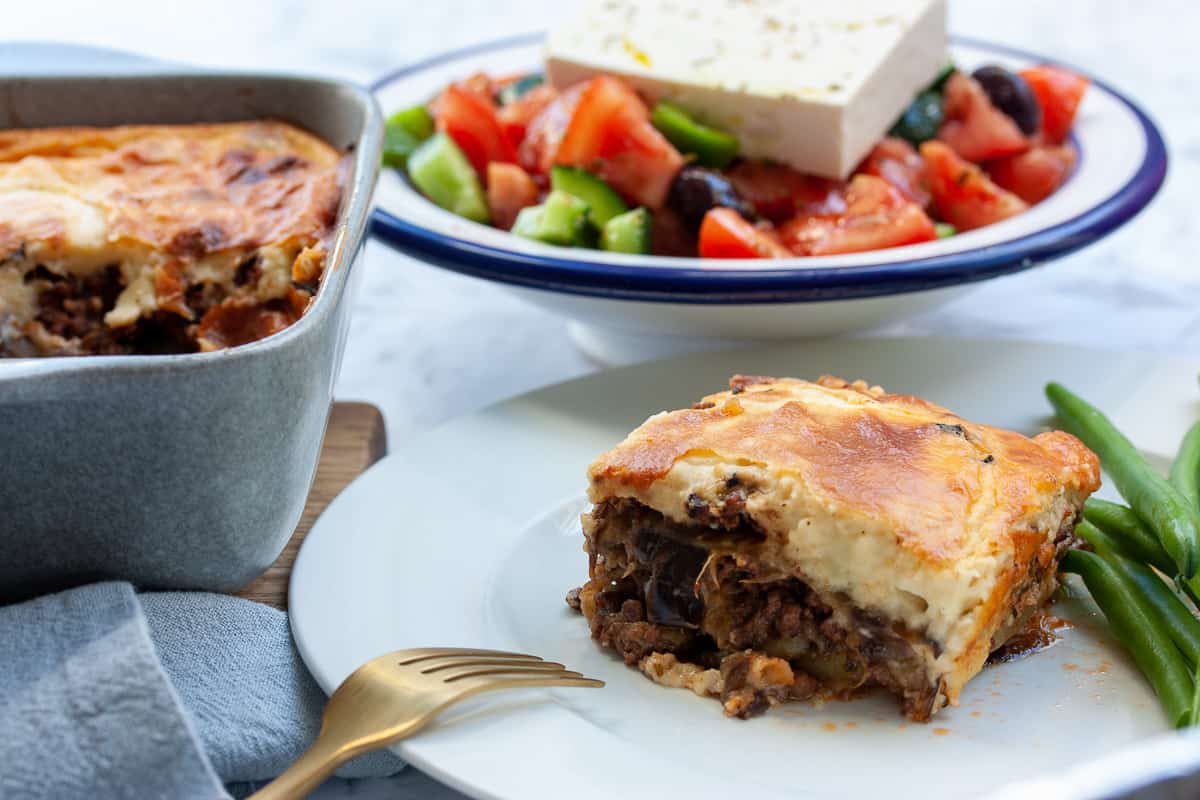
The layers of pre-prepared eggplant, potato and meat sauce are arranged in layers and baked for around 20 minutes. Meanwhile, we make the white sauce. We top the moussaka with the sauce and bake for another 20 minutes, until the topping is puffed and browned. Its important to let the moussaka cool slightly in the dish before cutting to serve.
All this dish needs is a simple fresh side to accompany it. Greek salad is perfect and/or simply steamed green beans.
Jump to:
❓ What makes up the layers in a moussaka?
It is a little time-consuming to prepare, but well worth the effort. There are four components that make up this moussaka:
- Sautéed eggplant/aubergine slices
- Boiled potato slices
- Beef mince simmered in a rich sauce - with wine, tomato paste, parsley and spices
- Creamy béchamel sauce to top - enriched with cheese and eggs.
🥘 Ingredients
This recipe is low FODMAP!
For a start, it contains no onion or garlic. Happily, this makes prepping the meat sauce a breeze (less chopping and peeling). I suggest lactose-free milk in the white sauce. The rest of the ingredients are naturally low FODMAP, at least in the quantities suggested here.
Moussaka 'Filling' Ingredients
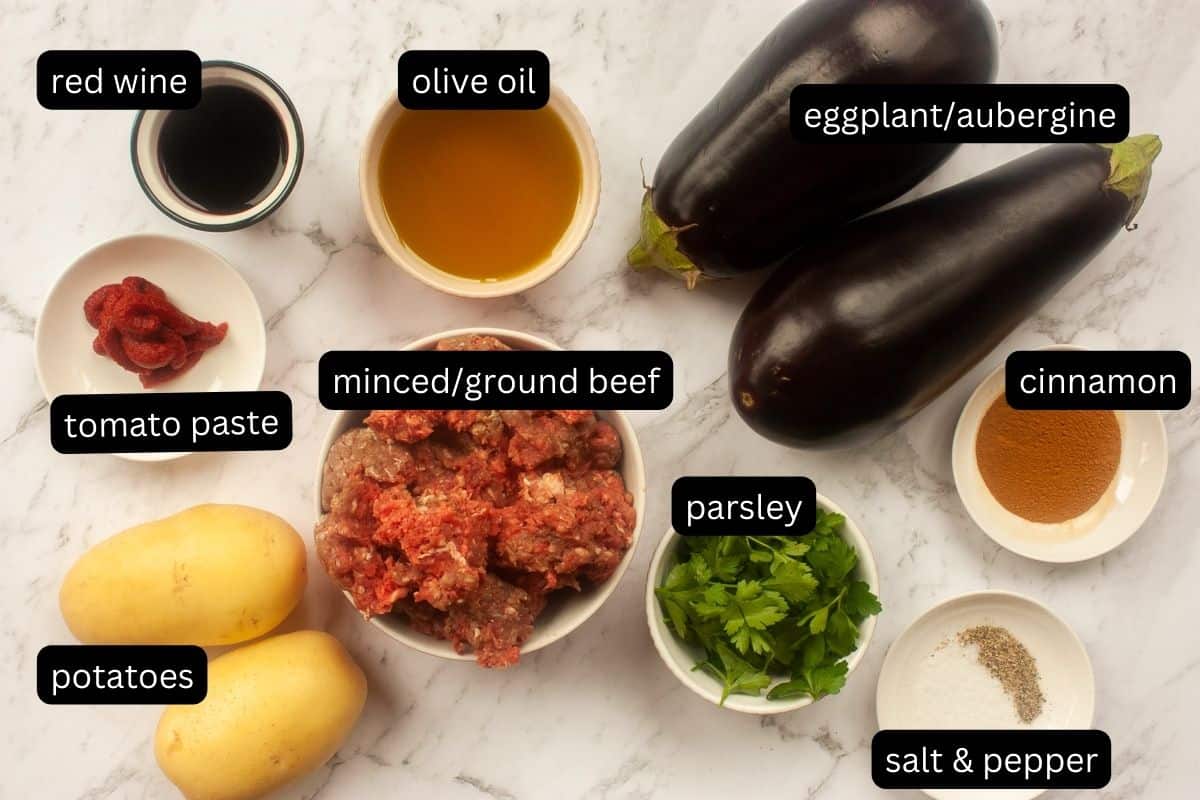
🍆Eggplant - Italian ones. We need a couple to thinly slice (no need to peel or salt first), brushed with olive oil and sautéed until soft and golden. Some moussaka recipes don't use potatoes, but a moussaka wouldn't be a moussaka without eggplant.
Potatoes - we only need one or two medium-sized ones to slice and form a single layer. We boil the slices first in salted water until soft; almost falling apart tender. Potato adds height to the dish, helps provide enough structure that a portion can stand up on its own. It gives the moussaka more substance so that it only needs a simple salad to accompany it and make it a complete meal.
Extra-Virgin Olive Oil - Greek food is plentiful in (good quality) olive oil. Moussaka is probably the most famous of Greece's dishes. It is unapologetically rich and unctuous on account of containing plenty of olive oil.
Ground/Mince beef - although lamb mince is often used in traditional moussaka; I prefer to use beef. Up to you. Whatever you decide; please don't use low-fat/very lean mince though. Fat is flavour people! How versatile is beef mince? Check out my low FODMAP bolognese and lasagna recipes.
Cinnamon - not so 'secret' spice often used in Greek cooking. A little goes a long way to making this moussaka taste authentic.
🍷Wine - a robust red is good here. Together with the tomato paste it makes a flavoursome liquid to simmer the meat in and create a small amount of sauce.
Parsley - often used in Mediterranean cooking. Adds a touch of appetising flecks of colour and fresh flavour.
Tomato Paste - way of adding concentrated tomato flavour to dishes without extra liquid.
Moussaka Topping Ingredients
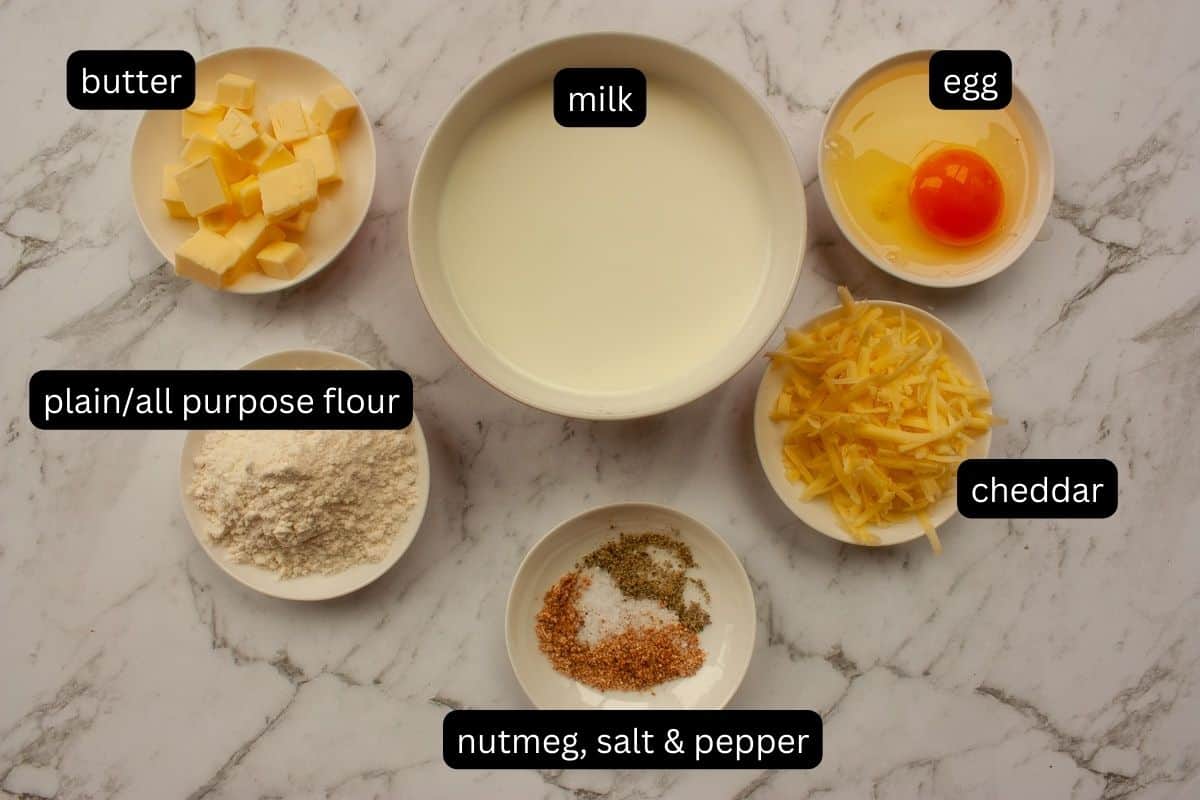
We use the usual flour and butter found in a typical béchamel sauce, combined with a little less milk than usual to create a thicker consistency. This will mean that the moussaka can be cut into servings that keep their shape without oozing and collapsing.
We enrich the sauce by melting in a small amount of cheese. I suggest a small amount of cheddar cheese to add to a rich texture of the sauce without an overpowering flavour. Freshly grated nutmeg adds a warm nutty flavour to white sauces. It's worth freshly grinding your nutmeg (rather than buying pre-ground); it will taste so much better. Whole nutmegs are fiddly, wood-like ovals. They're a bit tricky to grate. I highly recommend investing in a nutmeg grinder!
The addition of a whole egg loosens the sauce slightly (it will still be more dollop-able than pourable) and makes the topping puff up very satisfyingly on baking. This creates a rich, yet light and tall topping.
🔪 Instructions
The four recipe components - the meat sauce, eggplant, potatoes and béchamel - can be prepared in any order. They keep well and can be made in stages over a few days even and kept in the fridge until ready to assemble the moussaka. Having said this, the béchamel (white sauce) takes about 5 minutes to make and may as well come together while the rest of the moussaka is doing its first (untopped) bake.
Meat Sauce
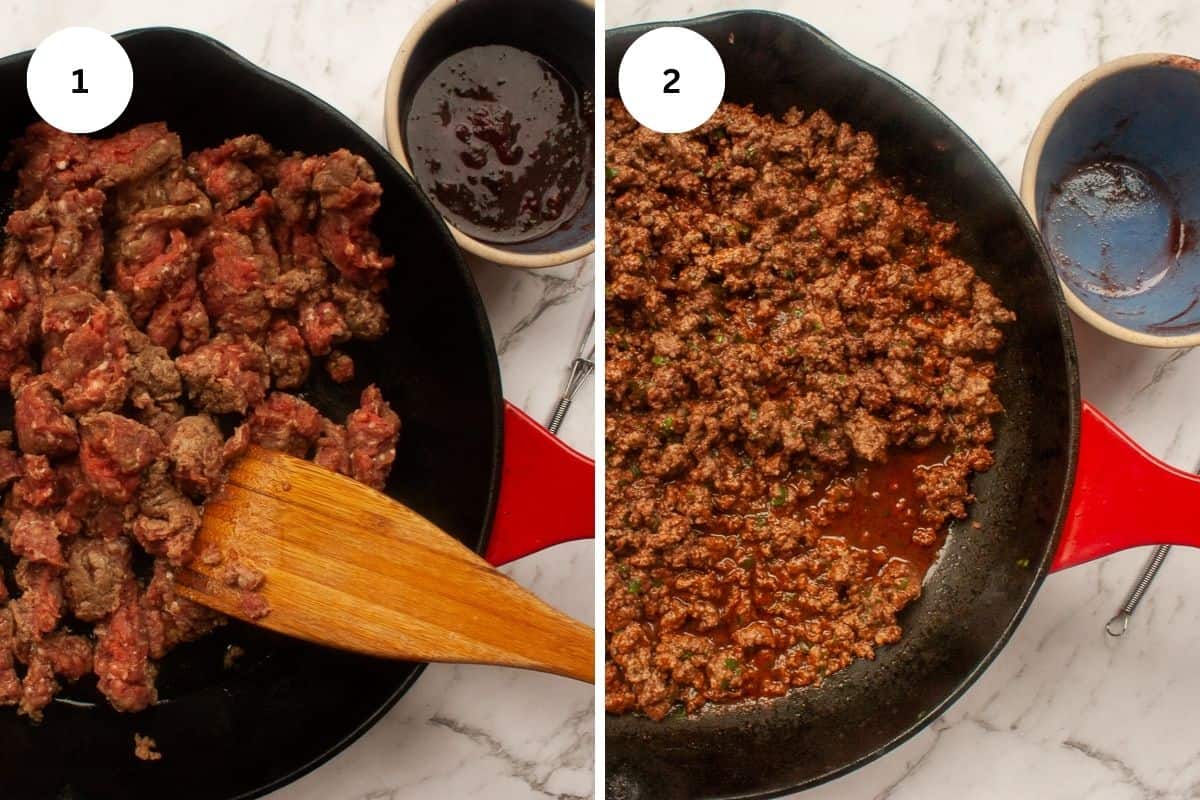
The meat sauce cooks in a (perhaps surprisingly) small amount of liquid. This is made by combining red wine, tomato paste, finely chopped parsley, cinnamon and seasoning. After briefly browning the meat (photo 1), this liquid is stirred through.
The meat sauce is left to gently simmer for around 45 minutes (photo 2). You might wonder if the mince mix looks too dry, particularly if you prepared it ahead of time and it is cold from the fridge. Trust me; it won't be. A good moussaka should be moist with olive oil, and not wet with excess water. You want to be able to serve it in generous portions that stay upright. Therefore, the meat 'sauce' is deliberately not very 'saucy'.
Sautéed Eggplant
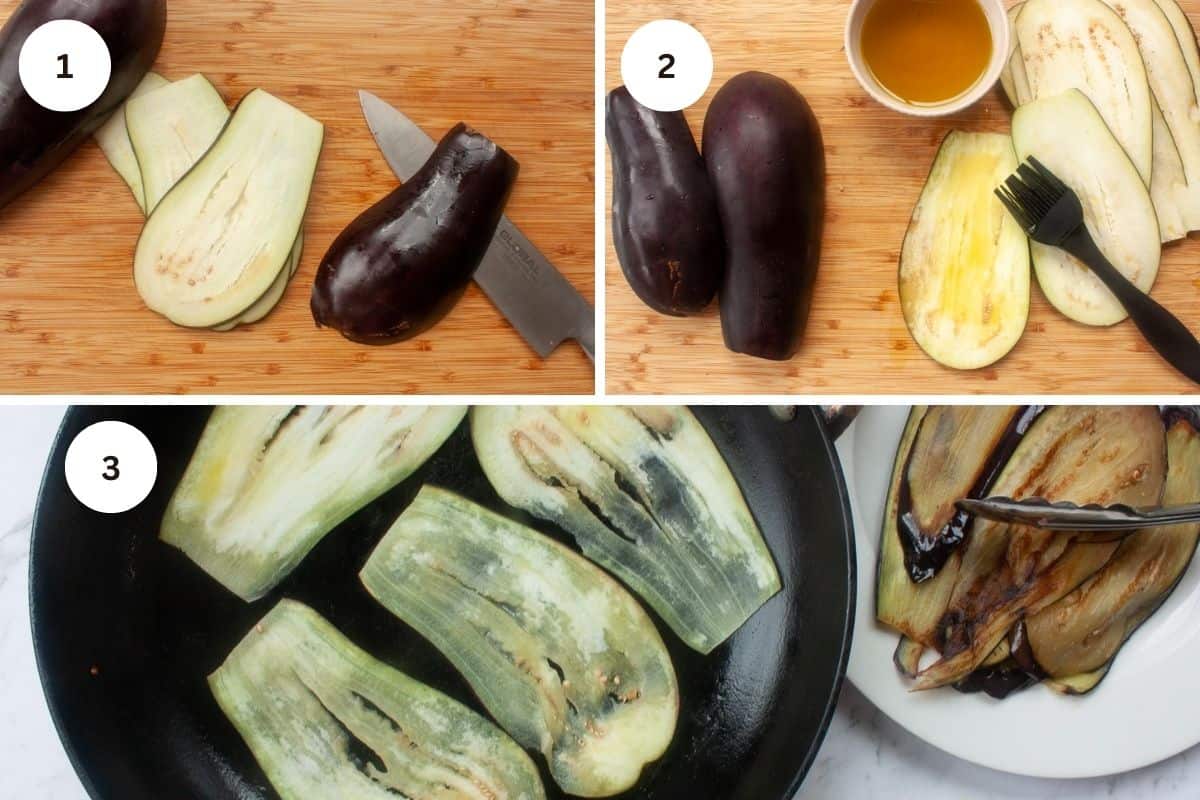
Photo 1 - we thinly slice the aubergine, aiming for about 3-4mm thick. It's nice to get them consistently sliced for cosmetic reasons, but not the end of the world if this is too hard! This is because we sauté the slices before layering. Any thicker slices will only take a little longer to soften and brown. The result will still taste good.
I've tried using a mandoline for slicing aubergines but found it too hard. Aubergines are a little spongy and can be too wide for many standard mandolines.
I find it easiest to rest the aubergine down along its length and make thin slices until the midway point. If you're having issues with the aubergine rocking around, you can cut off a thin slice and lay the eggplant down on the flat surface that creates. Once you have sliced half the eggplant, you can lay the aubergine down on the cut edge. Then slice across a few mms across the bottom. Remove the slice and repeat. You'll want to press down firmly with the non-cutting hand (keep your fingers out of the way!). Don't worry if some slices are thicker on one side than the other, or a bit raggedy. No one will be able to tell once it's all layered up. This dish is very forgiving!
Photo 2 - Brush both sides of the aubergine slices with oil.
Photo 3 - Sauté in a preheated pan. There is no need to oil the pan. Cook until the slices are golden brown on both sides. You can speed up this process by having two frying pans on the go. You'll need to stay close until this process is complete. The slices will need frequent tending to. You'll need to do a combo of flipping, moving, transferring and replacing the slices until they're all done.
I find that if you're going to sauté eggplant slices, you may as well do a little extra. They freeze like a dream. Depending on the size of your eggplants, you may not need all the slices you make. Don't cram them into the moussaka unnecessarily; save them for another time if you have too much. Or you can use them to make Aubergine Parmigiana or Vegetable Lasagna.
Potato

Photo 1 - peel and slice the potatoes. These are placed in cold salted water and the water brought to the boil. We then lower the temperature to maintain a gentle simmer (we want to bash the slices around too much) and the potatoes are cooked until soft, but not falling apart.
Once cooked, we need to be gentle with the potatoes while draining them - either lifting out the pieces with a slotted spoon or gently tipping them into a colander (Photo 2)
Layering
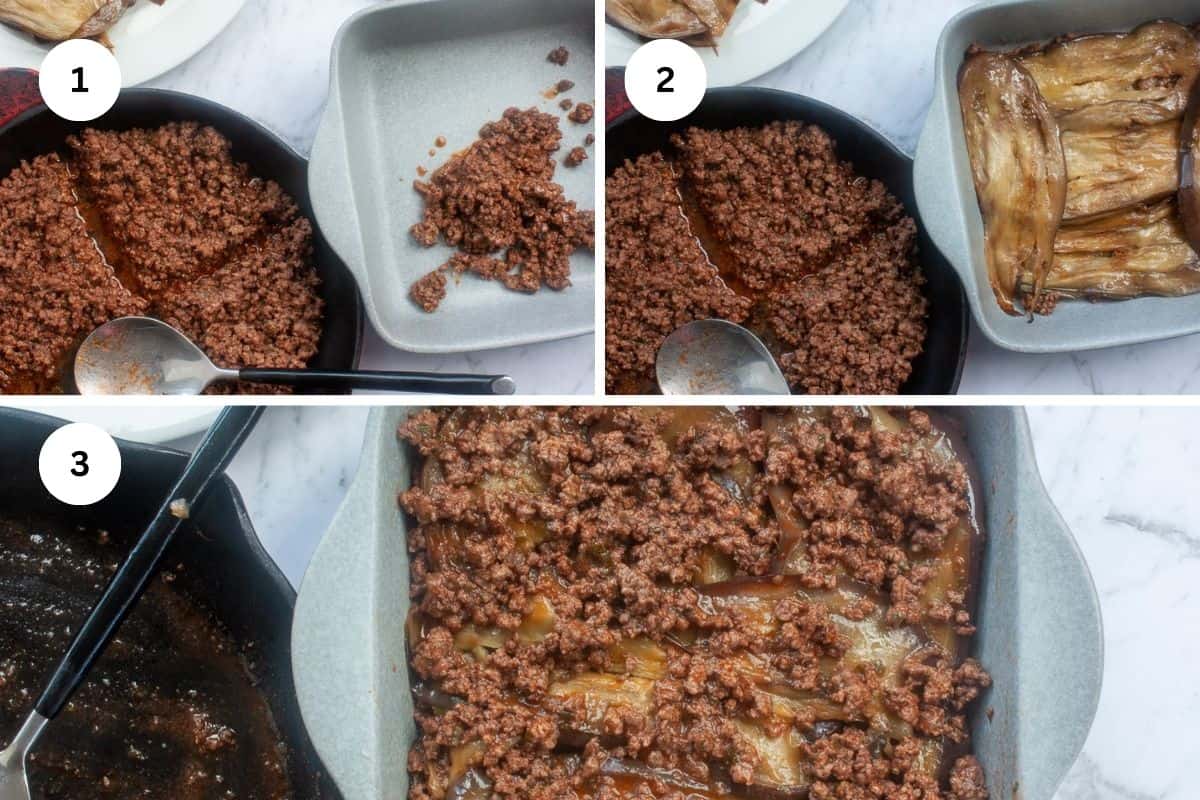
We layer the eggplant, meat sauce and potato, ending with meat sauce on top. I recommend doing one layer of potato, 3 layers of eggplant and 4 layers of meat sauce. You may find it easier to divide up your portions first.
Baking the moussaka before topping with the béchamel sauce improves the consistency- driving off excess moisture and intensifying flavours. It browns the top layer of mince beautifully too. The moussaka won't end up too sloppy to slice and serve. We do an initial 'untopped' bake for 20 minutes.
Béchamel Sauce
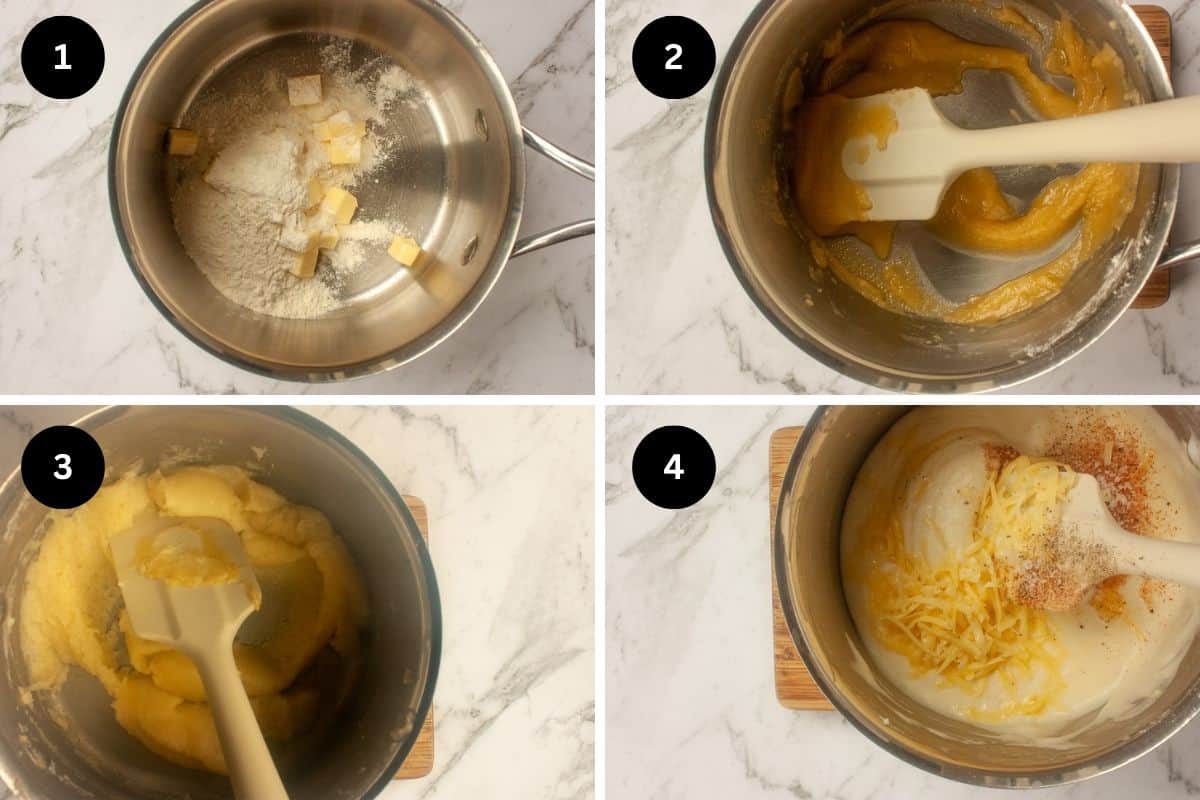
Photo 1 - we combine cold butter and flour in a small saucepan.
Photo 2 - blend together until the butter is melted and incorporated with the flour to form a very slightly browned paste.
Photo 3 - we work in the milk a little at a time until it is incorporated before adding more. Tip in all the cold milk at once (much quicker and works just as well!). Keep stirring until the mix comes to a bubble and thickens. A flexible spatula is good for schmearing in the milk and getting into the corners of the pan.
Photo 4 - add in grated cheese, nutmeg, seasoning and a whole whisked egg.

We top the moussaka with the white sauce. This is most easily done by placing dollops over the top and using a fork to spread out to completely cover the meat.
The moussaka is returned to the oven for another 20 minutes, until the top is browned and puffed up.
It's important to let the moussaka rest for around 15 minutes, before attempting to cut and serve. It needs to cool slightly so that it can hold its shape.
My kids love eating moussaka with a dollop of good ol' Heinz tomato sauce. A traditional Greek salad with a touch of acidity from the lemon juice, olives and feta is a more 'grown-up' way of complementing the richness.
Love Greek food? Check out a couple of my other Greek-inspired recipes - Gemista (vegetables stuffed with rice) and Braised Lamb Shoulder.
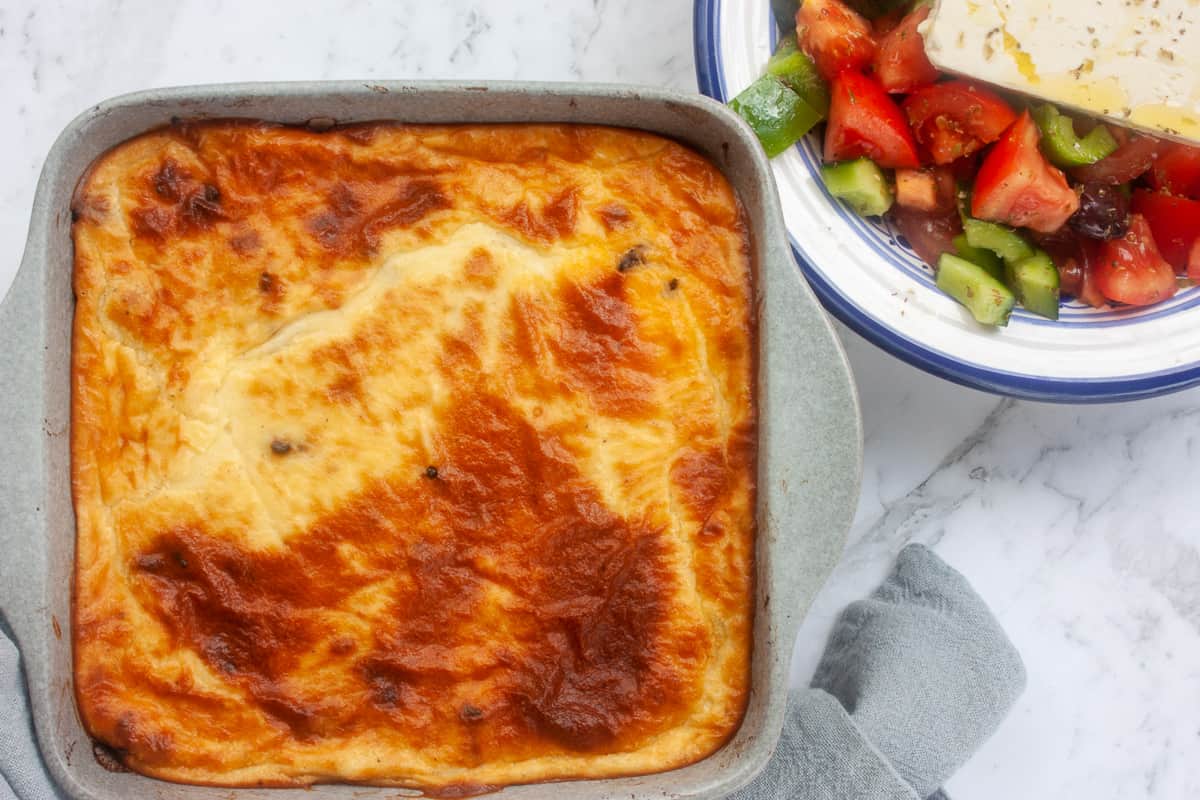
📖 Recipe
Equipment
- Deep baking dish about 20cm squared
Ingredients
Meat Sauce
- teaspoon ground cinnamon
- 30 g tomato paste
- 75 ml red wine
- large handful parsley leaves
- ½ teaspoon salt
- Freshly ground black pepper
- Tablespoon olive oil
- 500 g minced/ground beef
- 2 medium eggplant/aubergine
- About 120ml olive oil
- 2 medium-sized potatoes
Topping
- 40 g cold butter
- 40 g plain/all purpose flour
- 300 ml milk
- 25 g cheddar
- ½ teaspoon freshly grated nutmeg (about half a nutmeg's worth)
- ¼ teaspoon salt
- Freshly ground black pepper
- 1 egg
Instructions
Meat Sauce
- Prepare Sauce - in a small bowl add the cinnamon, tomato paste and wine. Finely chop the parsley and add this along with the salt and some freshly ground black pepper. Whisk together and set aside.teaspoon ground cinnamon30 g tomato paste75 ml red winelarge handful parsley leaves½ teaspoon saltFreshly ground black pepper
- Brown Meat - preheat the casserole pot over medium heat. Add the oil, turn up the heat to high and add the meat. Brown the meat, breaking up chunks with a flat-ended wooden spatula. We're not looking to get caramelised crispy meat here.Tablespoon olive oil500 g minced/ground beef
- Add Sauce - add the wine mix to the meat and stir through well. Very gently simmer for about 45 minutes with the lid on, stirring occasionally. You want to end up with tender meat that isn't too wet. While the meat is cooking, you can get the eggplant and potato slices prepped.
- Prepare Eggplant Slices - cut thin slices along the length of the eggplant, about ½ cm thick. Preheat a frying pan over medium heat. Brush both sides of the eggplant slices generously with olive oil (you can do this as you go along). Sauté on both sides in a frying pan over medium heat until golden brown and soft. Pile the slices up on a plate as they cook.2 medium eggplant/aubergineAbout 120ml olive oil
- Prepare Potato Slices - peel and slice the potatoes into ½ cm discs. Put the slices in a small saucepan with enough cold salted water to generously cover. Place over high heat and bring to a simmer. Reduce the heat and maintain a simmer until the potatoes are very soft but not falling apart, about 10-15 minutes. Lift out gently with a slotted spoon/tip out gently into a colander. It's not the end of the world if they break a bit.2 medium-sized potatoes
- Layering - preheat oven to 180°C. Arrange layers of mince, eggplant and potato in the baking dish. Divide the mince into four portions and the eggplant into three (no need to be overly precise).Scatter a portion of the mince over the base of the dish and spread out, top with a portion of eggplant (you may not need to use it all), then a layer of potato. Break up the potato slices to fill any gaps. Again, you may have some left over. Then:another portion of mince, layer of eggplant then,another portion of mince, layer of eggplant then,another portion of mince
- Bake (uncovered) - in the oven for 20 minutes, until the top is browned. You can make the topping during this initial bake.
Make Topping
- Butter & Flour - cut the butter into cubes. Add to a small saucepan with the flour. Cook over low heat, stirring often for a minute or two until the butter is melted and incorporated with the flour to form a very slightly browned paste.40 g cold butter40 g plain/all purpose flour
- Milk - tip in all the milk, increase the heat to medium. Keep stirring (drawing figures of 8 works well to keep everything on the move) until the mixture bubbles and thickens, which will take a few minutes. A flexible spatula is good for schmearing in the milk and getting into the corners of the pan. Take off the heat.300 ml milk
- Cheese, Nutmeg, Egg & Seasoning - grate the cheese and stir through the white sauce (it doesn't have to fully melt). Very finely grate the nutmeg, and sieve into the sauce so that there are no big bits. Allow the sauce to cool slightly, then stir through a lightly whisked whole egg, salt and pepper. Cover closely with plastic wrap if not using straight away so that you don't get a skin forming on the surface.25 g cheddar½ teaspoon freshly grated nutmeg¼ teaspoon saltFreshly ground black pepper1 egg
- Top Moussaka - remove the moussaka from the oven. Dollop over the white sauce and drag out with a fork to form an even layer, entirely covering the top.
- Second Bake - return to the oven and bake uncovered for another 20 minutes, until the white sauce is puffed up and scorched in spots and the underneath is bubbling around edges. Leave to cool for around 15 minutes before serving. The topping will collapse and get wrinkly. It's all good.
Notes
Simply substitute the flour in the topping with GF flour.


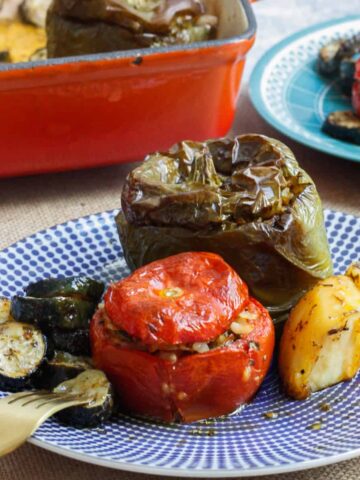
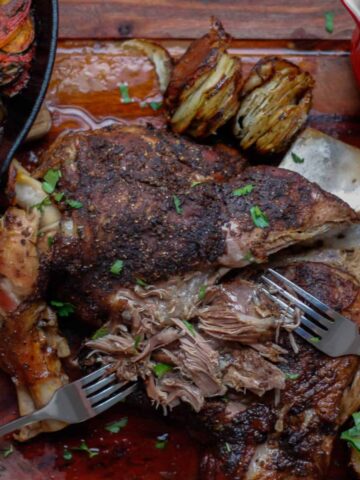

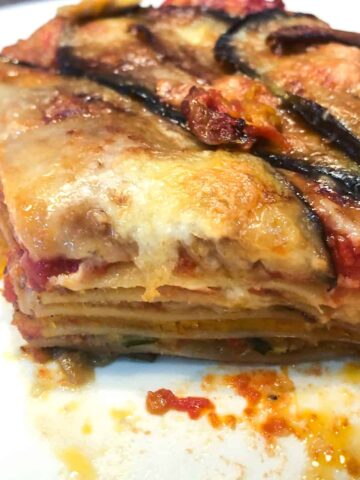
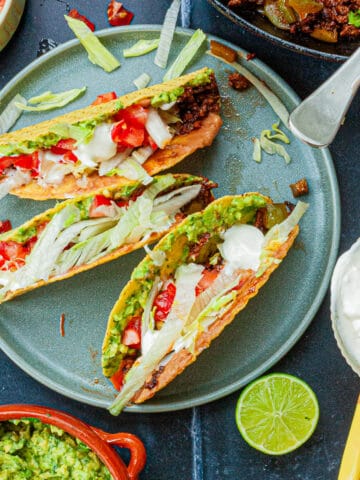
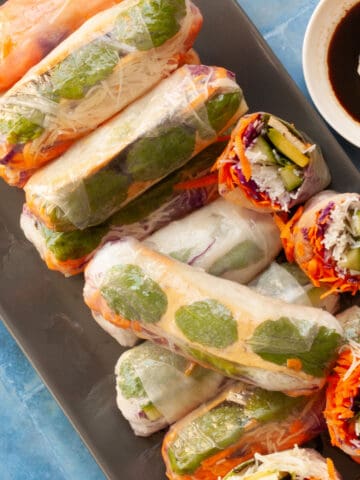
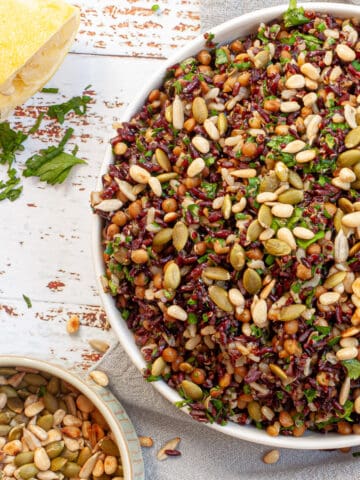
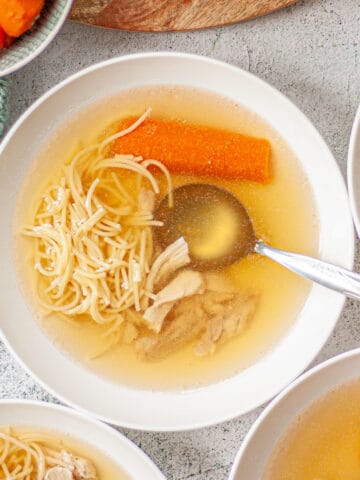
Comments